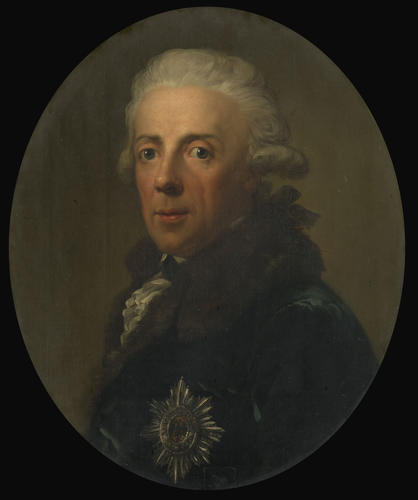Prince Henry of Prussia (1726-1802) 1777-89
Oil on canvas | 57.1 x 46.7 x 1.4 cm (support, canvas/panel/stretcher external) | RCIN 404054
-
Born the younger sibling of Frederick the Great of Prussia (Frederick II), Prince Henry remained forever in his elder brother's shadow. He was highly critical of Frederick the Great and objected to many of his military policies. A successful general and a shrewd statesman, Prince Henry never lost a battle during the Seven Years War (1756–1763) and was later, in 1786, put forward as a candidate for monarch of the United States - this offer was quickly revoked.
Known as the Van Dyck of Germany, Anton Graff was a prolific portrait painter, executing some 2000 paintings and drawings, 100 of which were self-portraits. An esteemed member of Prussian society, perched on the threshold between the Enlightenment and Romantic periods, Graff painted many of the most important figures of German history, including Friedrich Schiller, Heinrich von Kleist, Johann Gottfried Herder, Gotthold Ephraim Lessing and Moses Mendelssohn. Though a great number of his commissions came from the middle classes, Graff's most famous portrait was of the Prussian King Frederick the Great and he also painted the Russian, Polish and Baltic nobility. In 1778 he ended a brief account of his own life with "I owe Berlin much", meaning commissions from the Prussian court.
Graff is a connoisseur of the face, employing a theatrical, spotlit effect which teases out an enhanced psychology from his sitters. His earlier portraits are painted on monochrome backgrounds devoid of context, but his later works begin to introduce setting and surrounding objects. The emotional intensity of some of his portraiture is seen as proto-Romantic and certainly had an impact on his pupil Philip Otto Runge. Some of his later formal innovations, such as the use of impasto, are said to have had a bearing on Realism and Impressionism.
Born in northern Switzerland, Graff was a pupil of Johan Ulrich Schellenberg in Winterthur. In 1746 he moved to Bavaria and eventually became assistant to the court painter in Ansbach, Leonhard Schneider, with whom he produced large numbers of copies of a portrait of Frederick the Great (presumably by Antoine Pesne). In 1766 he was appointed court painter to Dresden and teacher for portrait painting at the city's Art Academy. He was also a member of the Art Academies in both Vienna and Munich.Provenance
First recorded hanging in the Visitors' Bedroom Lancaster Tower (Room no 243) at Windsor Castle in 1878
-
Creator(s)
Previously attributed to after (artist) -
Medium and techniques
Oil on canvas
Measurements
57.1 x 46.7 x 1.4 cm (support, canvas/panel/stretcher external)
68.8 x 58.5 x 4.2 cm (frame, external)
Alternative title(s)
Prince Heinrich of Prussia (1726-1802)








